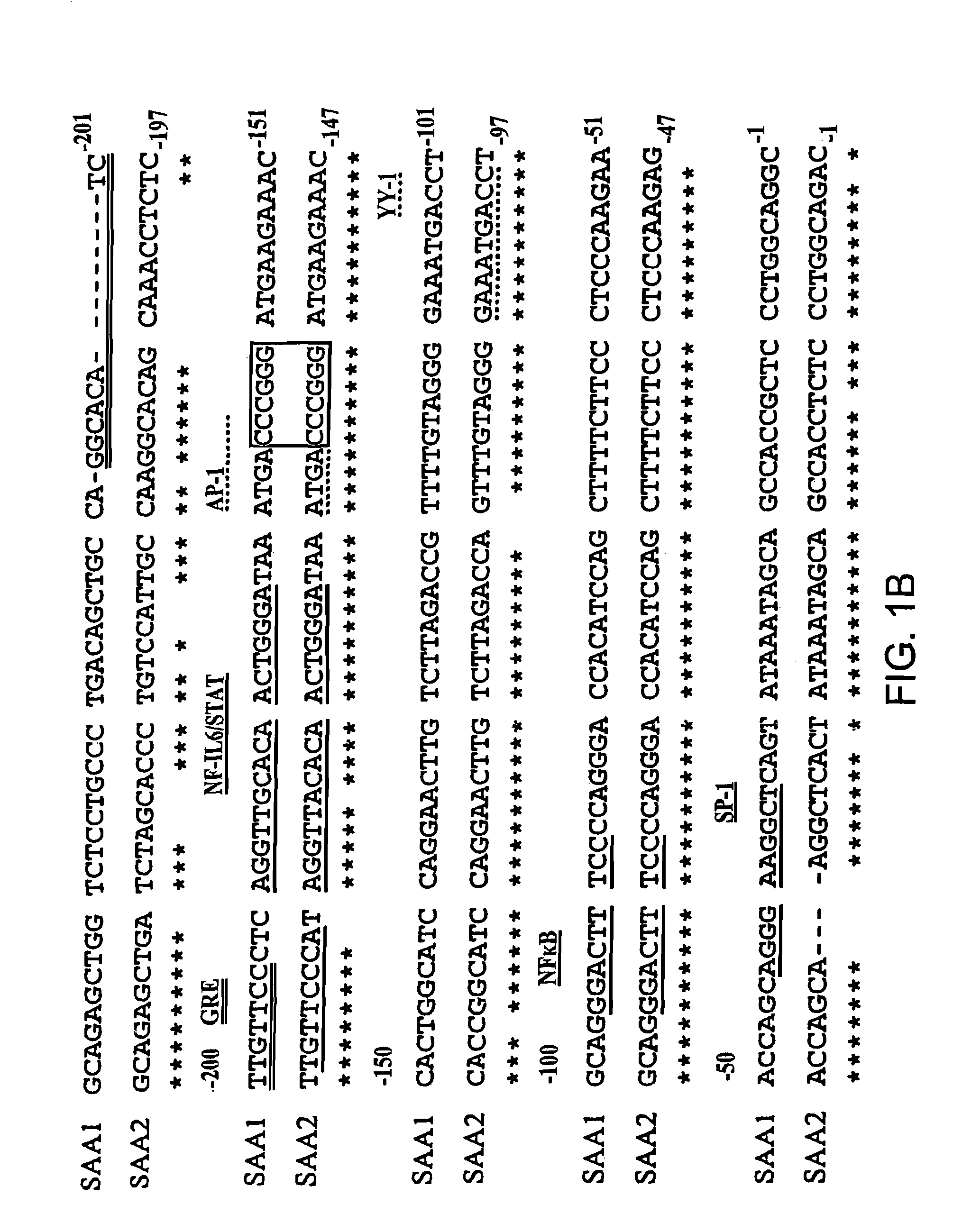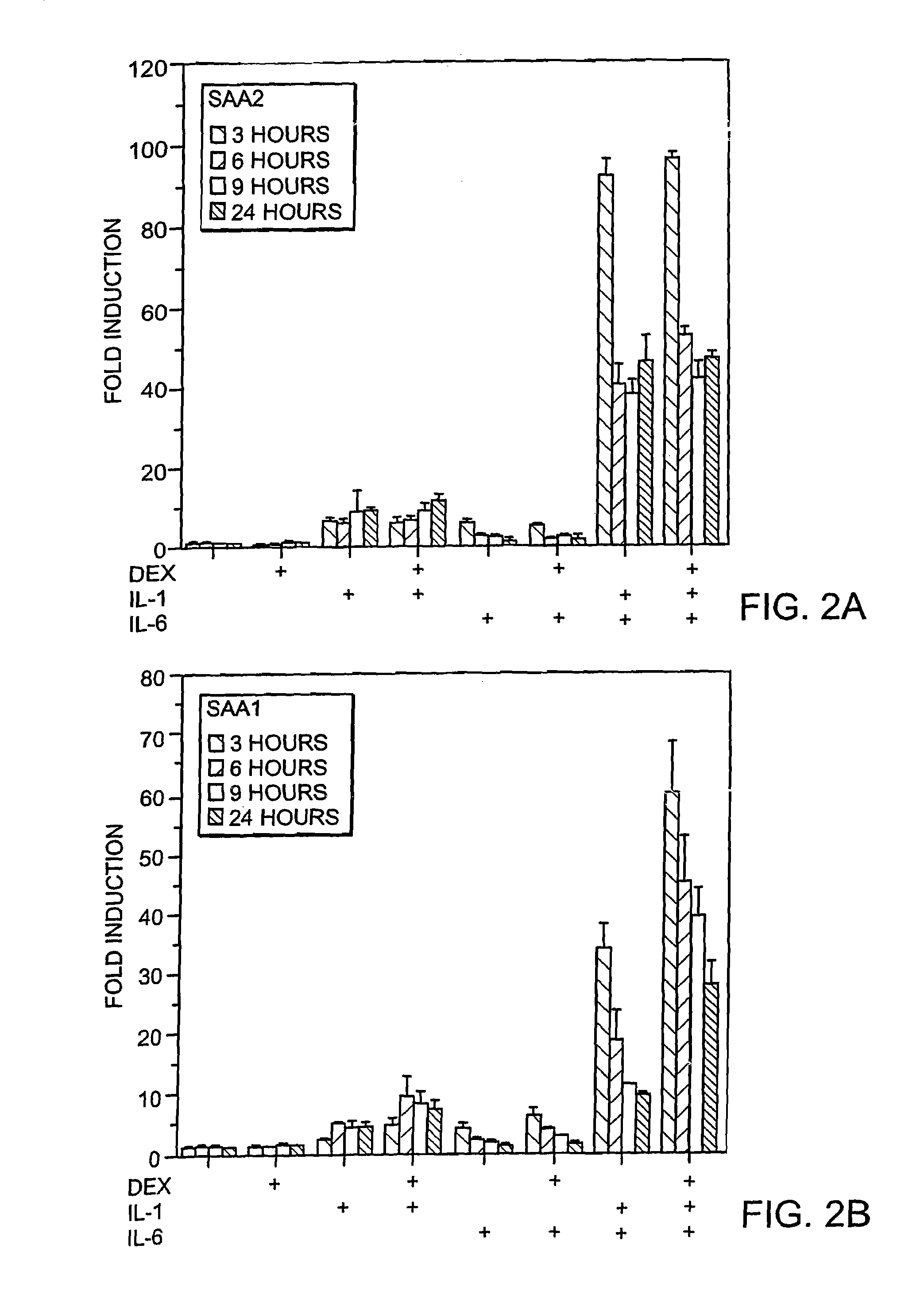Methods for determining drug responsiveness
a technology of responsiveness and diagnostic assay, applied in the direction of instruments, biochemistry apparatus and processes, material analysis, etc., can solve the problems of constitutively non, usually impossible to predict, and the effectiveness of steroid treatment varies, so as to minimize degradation of rna and dna, and minimize the degradation of proteins
- Summary
- Abstract
- Description
- Claims
- Application Information
AI Technical Summary
Benefits of technology
Problems solved by technology
Method used
Image
Examples
example 1
Differential SAA1 and SAA2 promoter engagement in a series of unmodified and modified promoter reporter constructs transfected into human HepG2 hepatoma cells using various combinations of IL-1, IL-6 and glucocorticoids.
SAA Promoter Luciferase Reporter Constructs
[0087]The pGL2-SAA2pt construct, which contains 1.2 kb of the human SAA2 promoter upstream of a luciferase reporter was generated as follows. A 1196 bp of the promoter region and 22 bp of the first exon of the human acute phase SAA2 gene was amplified by PCR with the introduction of MluI and XhoI restriction sites at the 5′ and 3′ ends respectively (5′ oligonucleotide: 5′AAGAATTCACGCGTCCATGCATGTTGCGGCCGCTTGGCCATCCTT-TACTTCCT-′3′ (SEQ ID NO: 8); 3′ oligonucleotide: 5′-TTGAATTCCTCGAGCAGGTA-CCATACATATGTAGCTGAGCTGCGGGTCC-3′ (SEQ ID NO:9). The PCR product was subsequently cloned into the multiple-cloning site of the pGL2-Basic vector (Promega, Madison, Wis. USA) which is located upstream of a luciferase reporter gene.
[0088]The pG...
example 2
Use of the RT-PCR assay to establish that the ratio of SAA1 and SAA2 products in HepG2 cells treated with IL-1 plus IL-6 changes according to whether glucocorticoid is present, in a manner analogous to that defined in promoter-reporter studies.
[0108]To determine whether the results obtained using the SAA1 and SAA2 promoter luciferase reporter constructs accurately reflect the regulation of the endogenous genes with respect to cytokines and glucocorticoids, an RT-PCR method was developed whereby the relative proportions of the transcription products of each gene could be directly compared. The SAA1 and SAA2 mRNAs, although highly similar (91% identical overall), differ significantly in the central region of their 3′UTRs; the SAA1 mRNA 3′UTR relative to that of the SAA2 mRNA 3′UTR has four “deletions” totaling 26 residues (FIG. 8A).
[0109]Forward and reverse PCR primers were designed, each of which can bind cDNA derived from either A-SAA mRNA (FIG. 8A). RT-PCR using these primers gener...
example 3
Evaluation of the glucocorticoid-dependent differential transcriptional activities of the SAA1 and SAA2 genes for use in determining steroid responsiveness in patients with diseases that have an inflammatory component.
[0111]Inflammatory bowel diseases (IBDs) (e.g., Crohn's and ulcerative colitis) are often treated with steroids, the efficacy of which is variable, both ab initio and over time. The assay according to the invention, which is based on the ratio of SAA1 to SAA2 mRNAs, is a useful tool for predicting and / or assessing steroid responder status. The assay is used to determine whether subjects suffering from IBD, for example, fall into four general categories: (i) in remission (not currently taking steroids but may have taken steroids in the past; (ii) steroid refractory (still with active disease, despite at least four weeks of steroid treatment); (iii) steroid dependent (quiescent on high doses of steroids, but tending to flare up if steroids are withdrawn); or (iv) active ...
PUM
| Property | Measurement | Unit |
|---|---|---|
| acute phase | aaaaa | aaaaa |
| concentrations | aaaaa | aaaaa |
| stability | aaaaa | aaaaa |
Abstract
Description
Claims
Application Information
 Login to View More
Login to View More - R&D
- Intellectual Property
- Life Sciences
- Materials
- Tech Scout
- Unparalleled Data Quality
- Higher Quality Content
- 60% Fewer Hallucinations
Browse by: Latest US Patents, China's latest patents, Technical Efficacy Thesaurus, Application Domain, Technology Topic, Popular Technical Reports.
© 2025 PatSnap. All rights reserved.Legal|Privacy policy|Modern Slavery Act Transparency Statement|Sitemap|About US| Contact US: help@patsnap.com



